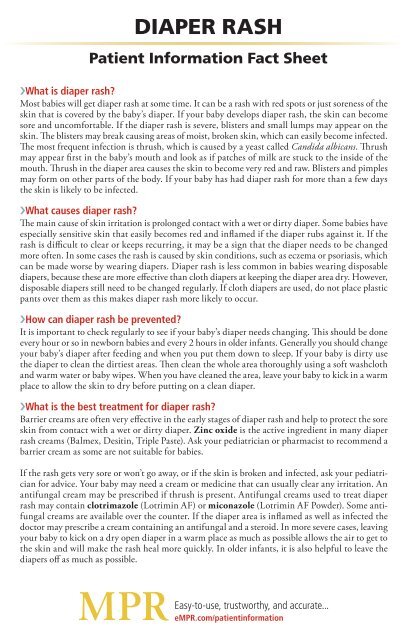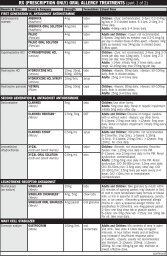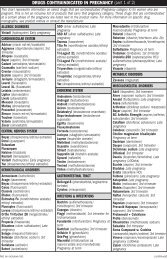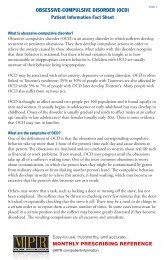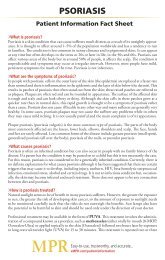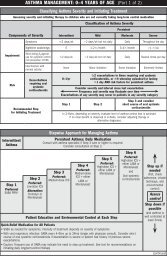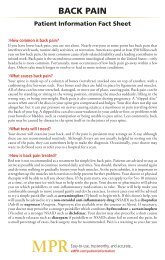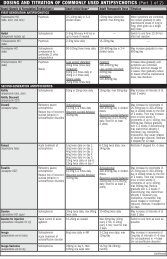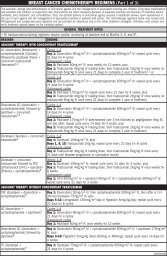diaper rash - MPR
diaper rash - MPR
diaper rash - MPR
Create successful ePaper yourself
Turn your PDF publications into a flip-book with our unique Google optimized e-Paper software.
<strong>diaper</strong> <strong>rash</strong><br />
Patient Information Fact Sheet<br />
›What is <strong>diaper</strong> <strong>rash</strong>?<br />
Most babies will get <strong>diaper</strong> <strong>rash</strong> at some time. It can be a <strong>rash</strong> with red spots or just soreness of the<br />
skin that is covered by the baby’s <strong>diaper</strong>. If your baby develops <strong>diaper</strong> <strong>rash</strong>, the skin can become<br />
sore and uncomfortable. If the <strong>diaper</strong> <strong>rash</strong> is severe, blisters and small lumps may appear on the<br />
skin. The blisters may break causing areas of moist, broken skin, which can easily become infected.<br />
The most frequent infection is thrush, which is caused by a yeast called Candida albicans. Thrush<br />
may appear first in the baby’s mouth and look as if patches of milk are stuck to the inside of the<br />
mouth. Thrush in the <strong>diaper</strong> area causes the skin to become very red and raw. Blisters and pimples<br />
may form on other parts of the body. If your baby has had <strong>diaper</strong> <strong>rash</strong> for more than a few days<br />
the skin is likely to be infected.<br />
›What causes <strong>diaper</strong> <strong>rash</strong>?<br />
The main cause of skin irritation is prolonged contact with a wet or dirty <strong>diaper</strong>. Some babies have<br />
especially sensitive skin that easily becomes red and inflamed if the <strong>diaper</strong> rubs against it. If the<br />
<strong>rash</strong> is difficult to clear or keeps recurring, it may be a sign that the <strong>diaper</strong> needs to be changed<br />
more often. In some cases the <strong>rash</strong> is caused by skin conditions, such as eczema or psoriasis, which<br />
can be made worse by wearing <strong>diaper</strong>s. Diaper <strong>rash</strong> is less common in babies wearing disposable<br />
<strong>diaper</strong>s, because these are more effective than cloth <strong>diaper</strong>s at keeping the <strong>diaper</strong> area dry. However,<br />
disposable <strong>diaper</strong>s still need to be changed regularly. If cloth <strong>diaper</strong>s are used, do not place plastic<br />
pants over them as this makes <strong>diaper</strong> <strong>rash</strong> more likely to occur.<br />
›How can <strong>diaper</strong> <strong>rash</strong> be prevented?<br />
It is important to check regularly to see if your baby’s <strong>diaper</strong> needs changing. This should be done<br />
every hour or so in newborn babies and every 2 hours in older infants. Generally you should change<br />
your baby’s <strong>diaper</strong> after feeding and when you put them down to sleep. If your baby is dirty use<br />
the <strong>diaper</strong> to clean the dirtiest areas. Then clean the whole area thoroughly using a soft washcloth<br />
and warm water or baby wipes. When you have cleaned the area, leave your baby to kick in a warm<br />
place to allow the skin to dry before putting on a clean <strong>diaper</strong>.<br />
›What is the best treatment for <strong>diaper</strong> <strong>rash</strong>?<br />
Barrier creams are often very effective in the early stages of <strong>diaper</strong> <strong>rash</strong> and help to protect the sore<br />
skin from contact with a wet or dirty <strong>diaper</strong>. Zinc oxide is the active ingredient in many <strong>diaper</strong><br />
<strong>rash</strong> creams (Balmex, Desitin, Triple Paste). Ask your pediatrician or pharmacist to recommend a<br />
barrier cream as some are not suitable for babies.<br />
If the <strong>rash</strong> gets very sore or won’t go away, or if the skin is broken and infected, ask your pediatrician<br />
for advice. Your baby may need a cream or medicine that can usually clear any irritation. An<br />
antifungal cream may be prescribed if thrush is present. Antifungal creams used to treat <strong>diaper</strong><br />
<strong>rash</strong> may contain clotrimazole (Lotrimin AF) or miconazole (Lotrimin AF Powder). Some antifungal<br />
creams are available over the counter. If the <strong>diaper</strong> area is inflamed as well as infected the<br />
doctor may prescribe a cream containing an antifungal and a steroid. In more severe cases, leaving<br />
your baby to kick on a dry open <strong>diaper</strong> in a warm place as much as possible allows the air to get to<br />
the skin and will make the <strong>rash</strong> heal more quickly. In older infants, it is also helpful to leave the<br />
<strong>diaper</strong>s off as much as possible.<br />
Easy-to-use, trustworthy, and accurate...<br />
e<strong>MPR</strong>.com/patientinformation
Diaper <strong>rash</strong><br />
Patient Information Fact Sheet<br />
page 2<br />
›Self-help measures<br />
• Change your baby’s <strong>diaper</strong> often to keep the skin in the <strong>diaper</strong> area dry and clean<br />
• When you change your baby’s <strong>diaper</strong> use a soft rag and warm water or baby wipes<br />
• Make sure your baby is clean and dry before putting him/her down to sleep<br />
• Use a barrier cream and <strong>diaper</strong> liners if your baby has <strong>diaper</strong> <strong>rash</strong><br />
• If the <strong>rash</strong> lasts for more than three days ask your pediatrician to check your baby<br />
• Tell your doctor if your baby has a skin problem on any other area of their body<br />
Last reviewed: May 2013<br />
Easy-to-use, trustworthy, and accurate...<br />
e<strong>MPR</strong>.com/patientinformation


